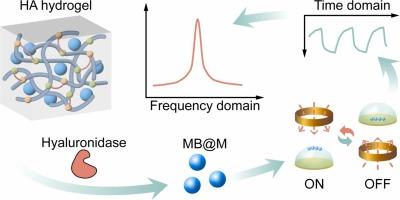A hyaluronidase detection platform combined with enzyme-responsive hydrogel and periodic magnetic-modulated electrochemical analysis system
IF 3.7
1区 化学
Q1 CHEMISTRY, ANALYTICAL
引用次数: 0
Abstract
Frequent invasive cystoscopies are required for bladder cancer management due to high recurrence and progression rates, significantly affecting the quality of life for patients. Hyaluronidase is a promising urinary biomarker that could potentially reduce the reliance on cystoscopy; however, its clinical utility depends on highly sensitive and specific detection methods. A major challenge is the common presence of hematuria in bladder cancer patients, as red blood cells in urine substantially interfere with hyaluronidase assays. Here, we present a platform for quantifying urinary hyaluronidase activity that operates directly in urine without the need for sample pre-treatment. This platform employs a hyaluronic acid hydrogel capable of specifically recognizing hyaluronidase. Enzymatic degradation of the hydrogel releases embedded magnetic beads, effectively converting the enzyme activity into a quantifiable magnetic bead signal. These released magnetic beads are then determined using a developed periodic magnetic-modulated electrochemical analysis system. The platform achieves hyaluronidase activity detection in the range of 2–25 U/mL, with a limit of detection of 0.414 U/mL. The specificity of hyaluronic acid hydrogel degradation, combined with the magnetic separation of magnetic beads, effectively reduces interference from other urinary components. In addition, the periodic magnetic controlled strategy introduces frequency-domain analysis into electrochemical amperometric signal processing, thereby avoiding the interference of baseline drift. Importantly, the platform demonstrates robust performance in detecting hyaluronidase in artificial hematuria samples, underscoring its substantial potential for clinical application in non-invasive bladder cancer monitoring.

酶响应水凝胶与周期性磁调制电化学分析系统相结合的透明质酸酶检测平台
膀胱癌的复发和进展率高,严重影响患者的生活质量,需要频繁进行有创膀胱镜检查。透明质酸酶是一种很有前途的尿液生物标志物,可以潜在地减少对膀胱镜检查的依赖;然而,其临床应用依赖于高灵敏度和特异性的检测方法。一个主要的挑战是膀胱癌患者普遍存在血尿,因为尿液中的红细胞实质上干扰了透明质酸酶的测定。在这里,我们提出了一个量化尿透明质酸酶活性的平台,该平台直接在尿液中运行,无需样品预处理。该平台采用透明质酸水凝胶,能够特异性识别透明质酸酶。酶降解水凝胶释放嵌入的磁珠,有效地将酶活性转化为可量化的磁珠信号。然后使用开发的周期性磁调制电化学分析系统来测定这些释放的磁珠。该平台可在2 ~ 25 U/mL范围内检测透明质酸酶活性,检出限为0.414 U/mL。透明质酸水凝胶降解的特异性,结合磁珠的磁分离,有效降低了其他尿液成分的干扰。此外,周期磁控策略将频域分析引入到电化学安培信号处理中,避免了基线漂移的干扰。重要的是,该平台在检测人工血尿样本中的透明质酸酶方面表现出强大的性能,强调了其在非侵入性膀胱癌监测中的临床应用潜力。
本文章由计算机程序翻译,如有差异,请以英文原文为准。
求助全文
约1分钟内获得全文
求助全文
来源期刊

Sensors and Actuators B: Chemical
工程技术-电化学
CiteScore
14.60
自引率
11.90%
发文量
1776
审稿时长
3.2 months
期刊介绍:
Sensors & Actuators, B: Chemical is an international journal focused on the research and development of chemical transducers. It covers chemical sensors and biosensors, chemical actuators, and analytical microsystems. The journal is interdisciplinary, aiming to publish original works showcasing substantial advancements beyond the current state of the art in these fields, with practical applicability to solving meaningful analytical problems. Review articles are accepted by invitation from an Editor of the journal.
 求助内容:
求助内容: 应助结果提醒方式:
应助结果提醒方式:


